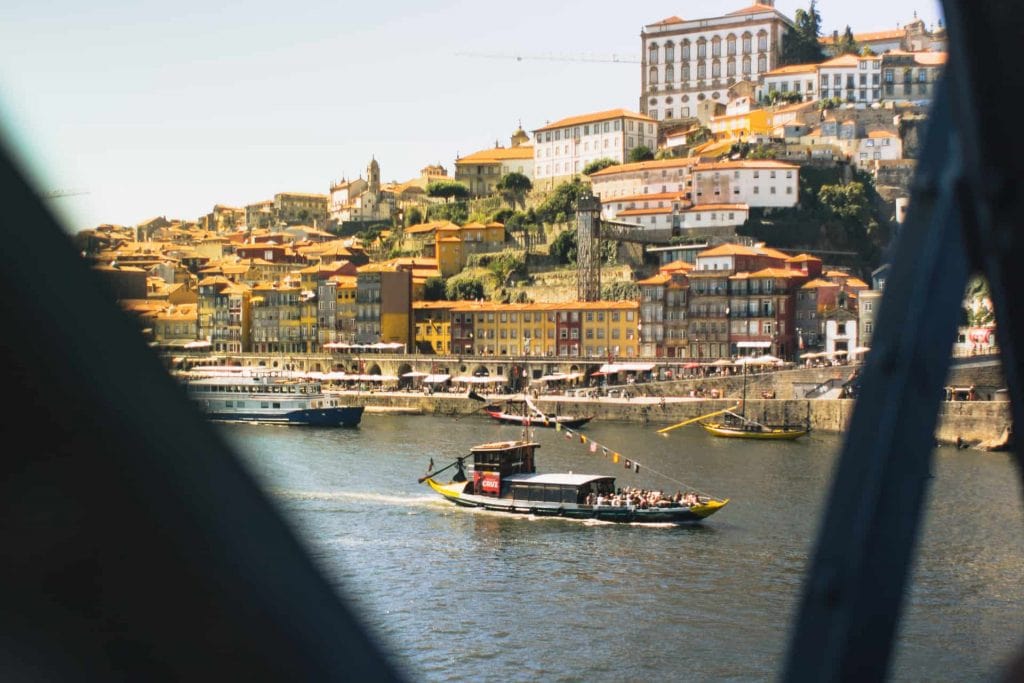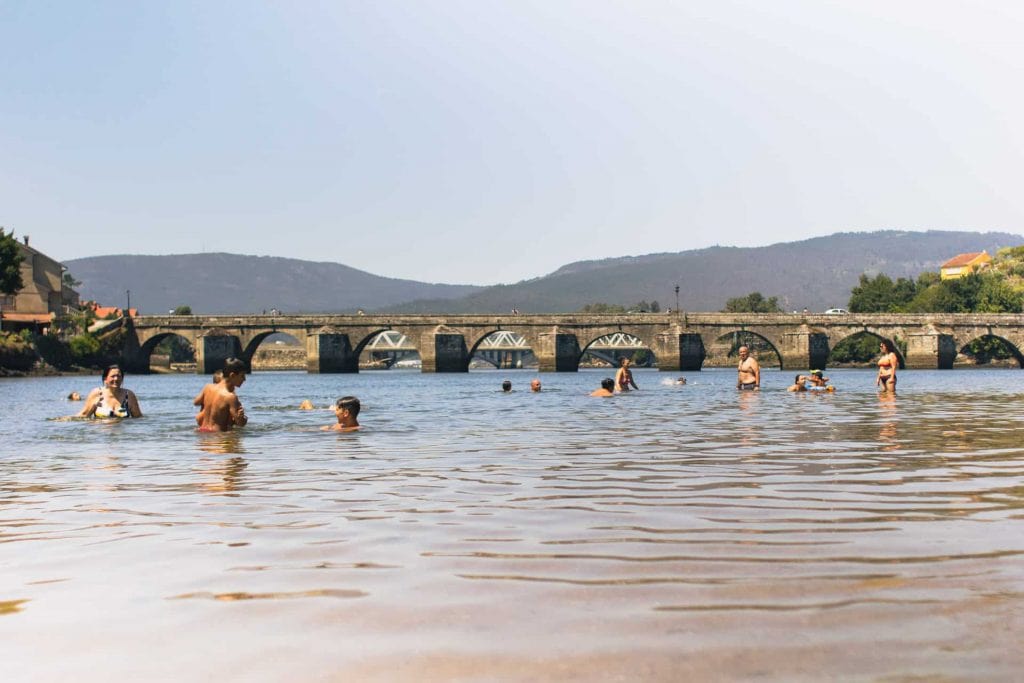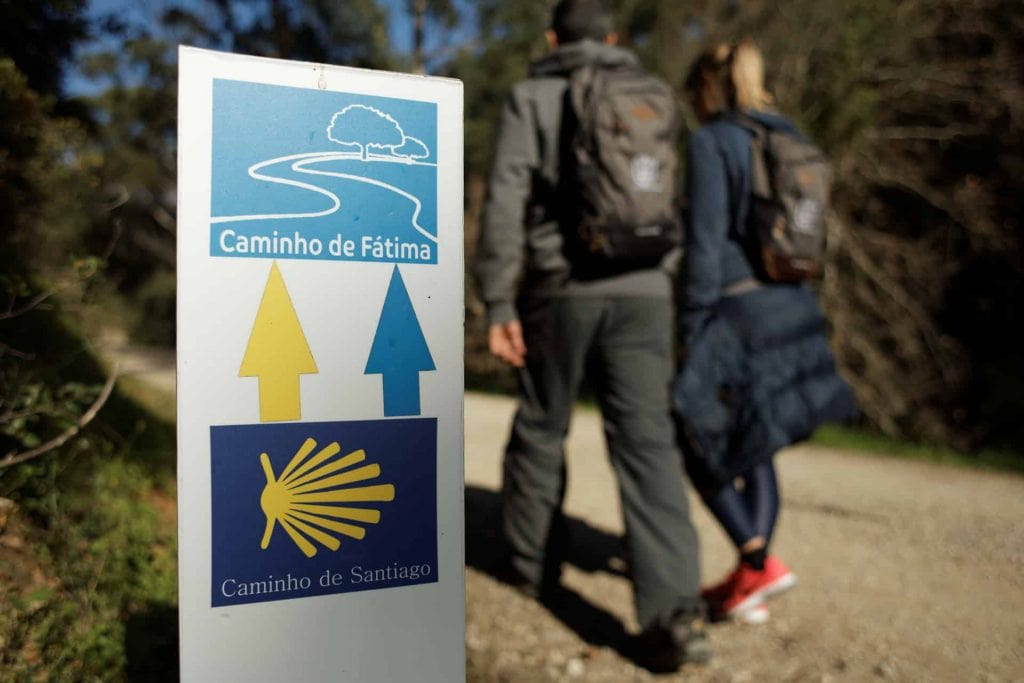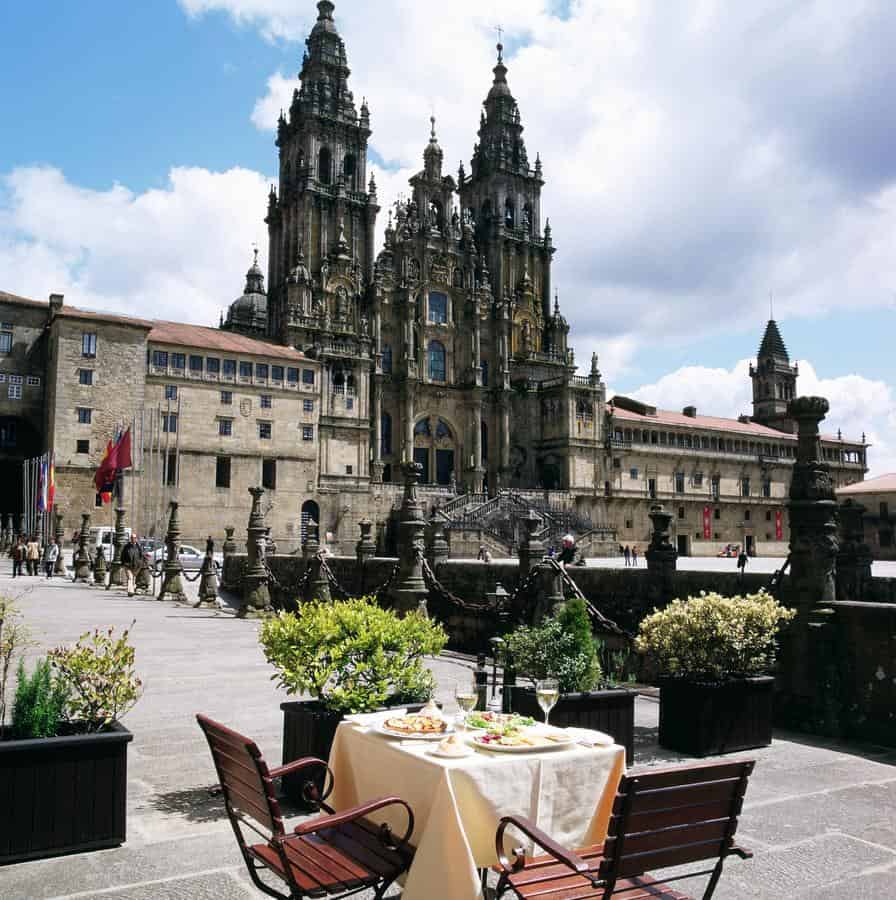US/CAN: +1 (917) 695-3350
EUR: (+351) 217 590 365
US/CAN: +1 (917) 695-3350
EUR: (+351) 217 590 365
If you are planning on walking the Camino de Santiago, you should consider walking the Portuguese Way, arriving at Porto then walking from Ponte de Lima towards Santiago de Compostela. This itinerary on the Central Way of St. James is one of our most participated Walking Tour Portugal and offers one of the most authentic ways to experience this pilgrimage, with the added bonus of visiting two countries (starting in Portugal and ending in Spain).
Whether you choose to walk the Camino as a pilgrimage to the Memorial of the Apostle Santiago or not, as you walk by the hills and valleys of the Way of St James with the goal of reaching the magnificent Cathedral of Santiago de Compostela, you'll find that is not only an adventure but a spiritual journey within yourself and with the hikers you meet along the way. A true pilgrimage - a spiritual commitment marked by faith, culture, nature, people and the sharing of stories that cross each other along the Camino.
In this article, we've tapped into our knowledge from operating our walking tour in the Portuguese Way to Santiago to share why, how, when and what to expect on your daily hikes as you go from Ponte de Lima to Santiago de Compostela. If you choose to walk all the way from Porto, please consider an additional 4 to 5 walking days. Check this guide that showcases the best to make the most of your walking journey in Portugal and Spain.

Why walk the Portuguese Way?
You’ll find a great climate, rich history and culture, world-renowned gastronomy, a true variety of trails and hiking paths as well as beautiful coastal and rural landscapes.
With an average annual temperature of 16°C and plenty of sunny days throughout the year, makes this area of north-western Portugal perfect for this walking trip. With a tempered maritime climate, due to its proximity to the ocean, you’ll be walking inland and protected from the coastal wind. During the winter months of December to March, you’ll still find moderate temperatures but also higher rainfall. August is usually the warmest month and temperatures tend to be agreeable to walk only in the morning.
The Way of St. James started out with the legend of the burial of the remains of Saint James, brought over by boat from Jerusalem, in the north of the Iberian Peninsula, in what is now Santiago de Compostela.
The pilgrimage to the Saint’s shrine began as early as the 9th Century and was very popular in Christian Europe throughout the medieval ages as a way to pay homage to Saint James, to earn indulgences and also sometimes as penance for sins committed. Legend also says that in 1325, the Portuguese Queen Isabel made a pilgrimage to Santiago de Compostela, following a route very similar to the one that today is marked with yellow arrows and started a tradition of what is known today as the Portuguese Way of St. James. In these days, besides religious reasons, many pilgrims walk, cycle or horseback ride the Way, for sport, to travel and get to know the regions and also as a way to find some spiritual retreat from our busy and stressful city lives.
Parallel to the significance of the Way of St. James there’s also the rich history of northern Portugal and Galicia, once part of the same kingdom right until the Portuguese independence in the 12th century. The common history of these bordering regions is still visible in the similarities you find today, even after more than 700 years of “separation”.
One of the main things you’ll notice while walking the Portuguese Way to Santiago are the common traces of the Romanesque architecture in the myriad of churches, manor houses and old bridges you’ll pass and visit. Learn more about the history of the Camino de Santiago on our blog post here.
What is more important after having a tough and exhausting walk during the day than to enjoy a delicious meal paired with great wine? In this aspect, both Portugal and Spain have delicious food, with a variety of fresh fish and seafood, so good to enjoy sitting outside in warm days, paired with the local chilled green wine. Easy to find is the hearty comfort food that you’ll be able to enjoy near the fireplace, with a glass of full-bodied red wine from the neighbouring regions of the Douro and La Rioja, or a bold green wine Albariño, from Minho and Galicia regions.
Being bathed by the Atlantic Ocean means both countries thrive on fantastic, fresh fish and seafood, expertly used in their trademark Mediterranean cuisine. But both countries have a great variety of cultures, climate variation and landscapes, which means each region has also an endless variety of nourishing stews, grilled and oven-baked meats, cheese, wines and local specialities. From Michelin star restaurants to regional “tascas” and “tapas” places, you’ll find yourself in a foodie’s heaven.
Walking the Central Way of Saint James will take you through ancient woods, roman paths, bucolic rural and forest landscapes. You’ll be able to rest in, visit and explore, exciting ancient cities with beautiful architecture from all eras that will make your travel so worthwhile. Deserving a special mention are places like the starting city of Porto, a sparkling jewel sprawling to the hills of the north bank of the Douro River, going all the way to the river mouth, and with its traditional buildings of dark granite stone, facades of bright colours, topped with red tile roofs. Already in Spain you won’t forget your visit to the cities of Pontevedra with the charming pedestrian centre area, where you’ll enjoy walking the medieval streets and buildings that surround the magnificent cathedral, a focal point for the pilgrims of the Way, but definitely not the only one, as you’ll find out by yourself, passing by the myriad of great restaurants with outside sitting areas that will enable you to live this city like the locals like to. Santiago de Compostela as your final destination is in itself a spectacular place to walk around and visit. The magnificent Cathedral dominates the central square and the medieval streets spread all the way to the old city walls.

When is the best time to go?
We suggest hiking from April to late October. Spring and late summer/autumn are the perfect seasons, while the summertime will always be tempered by winds from the North. Even early November can be considered, especially during the summer of St. Martin.
What type of terrain should I expect and what kind of gear will I need?
The paths and trails of the Portuguese Way are mainly composed of gravel and macadam trails, dirt paths through the woods, and some backroads. Use comfortable walking boots as the right boots will reduce the chance of sore feet, so that you can enjoy a blister-free trip. We recommend choosing walking boots with good ankle support, to cope with slippery or uneven paths and, if possible, bring another pair of lower cut boots, or trail shoes (a cross between trainers and boots) especially if your feet get hot in summer. Lightweight and waterproof materials are encouraged. Also try to bring several pairs of hiking socks, which normally have a more cushioned sole for extra comfort.
To ensure one’s comfort on the hike, it is important to wear the appropriate clothing. On these lighter, yet daily walks, always try to wear quick dry, lightweight walking t-shirts, pants and shorts, which will help wick moisture away from the skin and prevent from becoming chilled or overheated. When possible, bring a mid-weight fleece, ideal for layering with the t-shirt, and can be rolled up small to go in the rucksack when not in use.
What to expect and what how to navigate along the Portuguese way?
Throughout the way, you’ll encounter the Camino yellow marks, that point you towards Santiago. These are excellent and fail-proof ways to let you know that you are on the right way. You can choose to follow them, the whole way from Ponte de Lima to Santiago de Compostela cathedral. What differentiates the Portuguese path from the more known French or Spanish ones is its authenticity - the Camino is not as smooth as the others might be: on the contrary, it's more raw, authentic and adventurous. The central path will provide you with more historical and cultural depth in the Minho region, as you cross the beautiful Romanic cities of Barcelos, Ponte de Lima and Valença, with the iconic "Labruja" Sierra just outside Ponte de Lima.

How many days do you suggest the walk would take?
In order to walk the Camino in one week, we suggest you take the itinerary described below, the same we use on our Walking Tour in the Portuguese Way. If you choose to walk all the way from Porto, please consider an additional 4 to 5 walking days.
Day 1: Walking the Camino: Ponte de Lima - Rubiães (16km)
At Porto, head on to Sé Cathedral to pick-up your Pilgrim's passport - this document is essential for those who look to complete the Camino as a religious pilgrimage - stamp it at least twice a day and, once you reach Santiago, you can trade it for a Compostela certificate, at the Pilgrim's office. As you follow the famous yellow arrow and scallop shells by Porto's city center, you'll be able to visit the several historical points of interest in the city. While the central Camino will lead you towards "Rua das Flores", "Torre dos Clérigos" and "Avenida dos Aliados", the coastal path will lead you towards "Ribeira", by the Douro river, as you walk towards the Atlantic Ocean, enjoying the sights over Vila Nova de Gaia's wine cellars, were Port wine ages in cork oak barrels.
In order to be able to walk the Camino in a week, first you need to get to Ponte de Lima and start walking from there. You can get there directly by bus (1.30h trip), or by train until Barcelos, Barroselas or Viana de Castelo and then by taxi. Ponte de Lima is the oldest town of Portugal, was founded in 1125 and recently submitted its candidacy to UNESCO world heritage site - owing to its rich cultural, environmental and historic traditions.
After breakfast, start your day walking north, crossing the Lima river by the iconic bridge that gives the name to “Ponte de Lima”, and then keep walking by ancient roman pathways by the countryside, until you encounter the climb of the day, to the top of the Labruja sierra. Today, you’ll mostly climb by the forested areas of the sierra, walking by paved roads, roman pathways and gravel trails until you reach the Cross of the French, where tradition says you should leave a pebble to mark your passing. The views over the sierra and the pure quietness of this place are unforgetful. Start descending until you reach Rubiães for a well-deserved rest.
Day 2: Walking the Camino: Rubiães – Tui (17km)
After breakfast, today's hike will have you leaving the valley of the River Coura, walking mostly downhill in the first half of today's walk. The rest of the route is practically flat, as you'll pass by some small villages and a section of pretty woodlands before arriving at Valença, the last Portuguese city in the Central Camino and home to a magnificent fortress overlooking Tui (Spain) and the river Minho. After a hike inside Valenca's fortress, you'll cross the river and enter Spain and the beautiful city of Tui, marked by great examples of Gothic architecture. You'll be staying here for the night - make sure to explore the excellent restaurants in Tui's historical city center.
Day 3: Walking the Camino: Redondela - Pontevedra (17km)
After breakfast, we recommend getting tranfered just outside of Redondela - where the “central camino” and the “coastal camino” become one. If you prefer walking this section, please consider an additional 1 walking day with 28km length. From Redondela you'll start today's walk with a climb of 127 mts (417 feet) over a 2,5 kms (1.6 miles) distance, through the woodlands of the Camino, having an occasional peek at Vigo's Ria. Then the route follows a long descent until you reach the Romanic bridge of “Ponte Sampaio”, over the Verdugo river. After crossing, you'll have the last big climb of the day, followed by a descent and mostly flat terrain until Pontevedra, with its beautiful Parador and historical center. Take your time to explore Pontevedra’s center on a walk at nighttime by the Galician plazas of Ourense and Ferraria, where you’ll find the city’s Basilica and Chapel.
Day 4: Walking the Camino: Pontevedra – Caldas de Reis (24km)
Have breakfast before starting to walk towards north crossing "Ponte do Burgo", a stone bridge originally built on the XII century, over the Lérez river. On this day you'll be walking the second longest stage of this tour - with an accumulated total climb of only 231 mts (758 ft) over its 24 kms length, it is an easy and beautiful route. You'll continue hiking inland Galicia, with its lush green woods and forested areas, through Roman pathways and trails connecting quaint medieval villages that will end up leading you to an ancient thermal resort used by the Spanish noblemen, “Caldas dels Reis”. There, you may visit one of its thermal springs or explore the waterfall with its nearby roman bridge.
Day 5: Walking the Camino: Caldas de Reis - Padrón (19km)
With just another small stretch of forest, you will then be entering Pontecesures and the final part of today's stage. Cross the river and arrive in Padrón, a village known for being the cradle of Galicia and for its Green Peppers, the Padrón Peppers. Take some time to visit the village, climb to the Santiaguiño do Monte lookout point, visit the botanical gardens or Toxa waterfall and taste the food, If you’re adventurous and it’s in season, try the Lamprey.
Day 6: Walking the Camino: Padrón – Santiago de Compostela (26km)
After breakfast, you’ll begin the last stage of your Way of St. James. You’ll go through small villages and churches with clear signs that the end of the Way is near. When you arrive and enter the historical center of Santiago, you’ll reach the Santiago de Compostela Cathedral, the endpoint of your pilgrimage. Compostela is a millennial city with places and monuments that deserve a visit, such as its plazas in the central area of the old town, the narrow streets and traditional markets. Admire the Parador de Santiago (aka Hostal dos Reis Catolicos, originally built as a hospital and resthouse in 1499 for the sick and weary pilgrims visiting this Galician capital city), and then dedicate the rest of your afternoon to visit the pilgrims' office and discover this medieval city’s traditions, culture and heritage. Get your Compostela from the local pilgrim’s office and, at 12:00 you can participate in the daily Pilgrims' mass, where you may be able to witness the “Bota Fumeiro”. The Pilgrims mass is held daily at noon, and sometimes there will be additional sessions.

As you arrive in Santiago de Compostela and reach the highlight of the pilgrimage - the entrance to the magnificent Cathedral - you'll experience much more than the end of an adventure. You'll remember all the pilgrims that have crossed your path, the new experiences you lived and the difficulties you conquered along the Camino. It is said the Camino neve truly ends, and we are firms believers in that. Whatever the reason you have to join this adventure, hiking the Portuguese Camino de Santiago is an experience of a lifetime!
Click here for more information on our guided hiking tour from Porto to Santiago.
Live Love Hike
Avenida Infante D. Henrique, 311
1950-421
Lisbon - Portugal
Monday to Friday
09AM to 06PM GMT
EUR: (+351) 217 590 365 - Call to the Portuguese national fixed network
US/CAN: +1 (917) 695-3350
Describe what and how you want to explore Portugal on foot and let our consultants suggest the best options for you:
This form is currently closed for submissions.